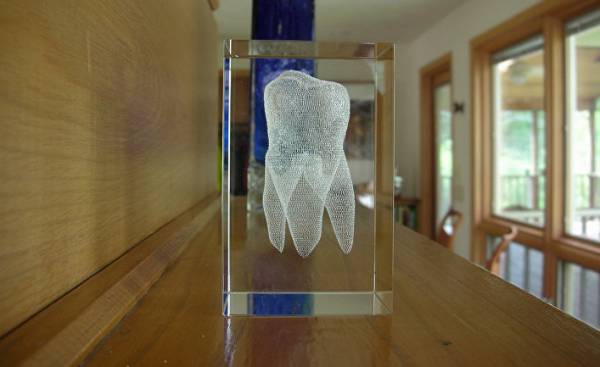
One day last summer, Timothy Bromage (Timothy Bromage), a paleontologist at the University of new York, resting in Cyprus, munching lamb chops. Suddenly he heard a crunch. When the sound came a sharp pain, he realized that he broke a tooth.
When he returned to new York, his dentist told him that he will be forced to postpone three months of torment, if he wants to restore the tooth. “Or just give me five minutes,’ said the doctor, and I’ll yank it right now.”
Bromage chose delete. Thus he was able to make a thin slice of the tooth, that is what he wanted to do for several years to measure a new type of biorhythm, which he studied in permanent teeth of mammals. It is not well-studied circadian biorhythm, and longer, differing from species to species, lasting from two days to two weeks. Bromide believes that this rhythm can set the tempo of growth of animals and their life expectancy.
Rats biorhythm lasts one day; in macaques, four sheep five, people from six to 12 days. Bromide confirmed this relationship among the dozens of other living and extinct mammals, including Asian elephants, whose biorhythm lasts for 14 days. (There are exceptions: for example, in dogs, this relationship is not traced).
In General, a slower rate in larger mammals is justified: larger animals grow more slowly than smaller animals, spending longer periods of time. Bromide believes that the rhythm of teeth and bones reflects the signal growth, stimulating the rate of cell division, the cells of the body receive this signal at regular intervals. The more there are such signals, the faster growing animal.
The rhythmic interval increases not only with weight, Bromage found that it increases along with other features, growing along with body weight, for example, life expectancy, duration of lactation, metabolic rate, duration of estrous cycle and size of the kidneys. This suggests that, by measuring the rhythm of growth of just one tooth, even the extinct animal, it will be possible to determine not only the size of his body, but many of its features.
“Give me any tooth, any permanent tooth of a Primate — just throw it to me, don’t say it’s for primacy, and I reenact what size he had his kidney, his life expectancy, all of these features,” says Bromage. “Unbelievable, what a window of opportunity opens this material to find the key to life.”
Received a prestigious research award max Planck and a colleague in 2010, Bromage spent 750 million euros on research, which determines whether recorded in blood samples of animals of the same rhythms as in the samples of teeth. Studies were expensive and demanded a lot of time, including the fact that mice and rats (cheap workhorses of biology) no multi-day rhythm, therefore they cannot be used as a test.
The results of a study published in 2016, while solid enough to be a discovery. A chronobiology are skeptical about it.
However, “Suddenly he was right after all?”, — asks Robin Bernstein (Robin Bernstein), biologist, anthropologist from the University of Colorado at boulder, who studied the evolution of body size and who is now examining the growth of people and pchelopitomnik primates. “In my opinion, he’s one of those people who are ahead of their time,” she says. “Maybe there is nothing special here, but it is original, really interesting, and I think this could be a lot to do.”
Dental connection
Bromage interested in the teeth when I was a graduate student in the mid 80-ies. At that time, scientists knew that similar to how the trees are formed by annual rings, on the tooth enamel are formed daily growth bands. Japanese scientists in the 1930-1940-ies found them on the teeth of dogs, rats, pigs and macaques.
In mammals, there are also noticeable stripes, which are called stripes Retzius. Among early hominids, which were studied at that time Bromac, every line of Retzius shared seven daily strips. Nobody knew how and why they were formed, but Bromide could use them as a marker to show that the first permanent molars appear in early hominids at the age of about three years, as in chimpanzees, i.e. much earlier than in modern humans. This meant that early hominids were not just miniature versions of modern humans, as it was considered, but was closer to the apes.
In 1991, Bromide confirmed that the line of Retzius in macaques were separated only by four lines of the daily growth, in contrast to seven, marked them among the early hominids. Then in 2000, he realized that the bones also have a scheme of periodic growth. He found that the stripes, which are called lamellae, are formed on the bones of rats in just one day. How was it possible, if the human bones are growing much slower than the rat?
“It’s not been on my head for many years,” says Bromage. And then one day in 2008 he read in the thesis of one of his students that lamellae are formed in the bones of macaques in four days, that is exactly the same as the line of Retzius, which he found in the teeth of macaques in 1991. “The memory of 1991 arose in my mind in the same second as I saw the number four,” he recalls. Is it possible, he wondered, that in mammals the same periods of growth in teeth and bones? If so, then the lamellae of the people as well should be formed in seven days, much longer than in rats, which is required for this one day.
Bromage called the idea “completely new paradigm”. Until that time, it was considered that there is no connection between how growing teeth and bones; bones never considered cloth, which develops a gradual, measured stages, such as the teeth and trees. Any possible link between the pace of development of teeth and bones was so important that whole week I could not to say anything to anyone,” says Bromage, even his wife. He checked histological structure of bones and teeth in the laboratory and found that indeed the rhythms of growth of teeth and bones matched at monkeys, sheep and humans.
The rhythm of the brain
If the rhythms that Bramec saw in the bands of growth of teeth and bones of mammals, was a reaction to a signal of growth, where the signal could be originating? Bromide believes that its source is the same part of the brain that, as already known, sets the circadian biorhythm, that is, the hypothalamus. In the end, the length of the studied biorhythms is always a multiple of a whole day, and biological clock, as we’ve established, affect the rate of cell division. The hypothalamus is able to perform this function, so “why invent another completely new tool?”, — had a question. Something, perhaps the substance accumulating in the hypothalamus, can vary biological clock in a multi-day cycle. Whatever part of the brain was responsible for this, “she intended only to be considered,” says Bromage.
The hypothalamus does two jobs: it regulates the pituitary gland, pituitary gland produces hormones, the front of which regulates the size of the body, and the rear — the duration of the estrous cycle. Maybe it’s no coincidence that the only two physiological features, which revealed Bromage, directly correlated with the duration of the new biorhythm.
Bromide began to test his theory. If generated in the brain signal regulates the rate of growth, thinking Bromide, the blood should carry the traces of this signal.
Bromide spent two weeks collecting six milliliters of blood samples from pigs. Then he transferred his collection from 33 pigs 1700 samples to an independent laboratory to identify 995 different metabolites, biochemical substances produced by the body.
Spending 300 thousand dollars, he received the answer: of the 159 most concentrated metabolites with specific biological function 108 reflect the circadian rhythm. The next most frequent rhythm was the same five days that Bromide revealed in teeth and bones of pigs. Only 55 of 159 metabolites passed through this cycle, and only a 20-year cycle coincided with different rhythms.
To his surprise, Bromide revealed two five-day cycle with a period of three days. The first contained metabolites associated with growth and the other metabolites formed during the decay of biological molecules. It was logical: when the growth is finished, the metabolites need to survive the collapse to become available for processing in the next cycle of growth. “What a delicately arranged system, thought Bromage, I wouldn’t have believed it if I hadn’t seen it with my own eyes!”
He named the new biorhythm “Fluctuations Havers-Halberg”. The name was given in honor of Clopton Havers (Clopton Havers), who in the late 17th century, first described the lamellae of the bones that would later become known as strips of Retzius; and Franz Halberg (Halberg Franz), chronobiology, who died in 2013 at the age of 93 years.
The problem with the pigs
Looking back, we realize that to call the rhythm in honor of Halberg was not the wisest decision.
Chronobiology have become extremely skeptical about the discovery of multi-day biorhythms, says Roberto Refinetti (Roberto Refinetti), a physiologist from the University in Boise, author of a textbook on circadian physiology. And we owe that largely to the Halberg. He introduced the term “circadian”. Later, however, he announced the opening of a longer rhythms without presenting tangible evidence. “He was truly, as he liked to say, a man of broad views, — said Refinetti — Some believed that he even goes beyond the permissible limits”.
Refinetti, and he tried (and failed) to identify a weekly rhythm in blood pressure and concentration of lactic acid in the blood of horses. He believes that five-day rhythm in pigs identified by Bromagem, could be the result of the working week people, a relatively new social invention. Moreover, he says, nothing in the environment could lead to the development of a weekly rhythm for millions of years. Compare that with your circadian rhythm, which apparently arose as a reaction to the change of day and night.
Bromage answered that revealed to them the rhythms most likely cannot be caused by the work week, because the pigs all the time were kept in unchanged conditions. Moreover, if the theory of Bromidia is correct, then for the development of these rhythms would not need multi-day external signal, as they are based on daily hours that can be counted. Refinetti, he added, probably not noted the weekly rhythm of the horses, because I did not measure the whole complex associated with growth.
As for criticism of the data of Halberg, Bromage said called rhythm in his honor because he “defended a long-term rhythms, when not thought about it no one on earth.” But it says Bromage doesn’t mean “I agree with all of his assertions”.
Difficult to argue, probably, with statistics according to Promega. Due to the cost and complexity of the experiment had to be carried out in a shorter time than expected Bromide. Because cycles were too little, he was not able statistically to objectively test rhythms. Instead, the situation led him to the assumption of a five-day rhythm, and then check whether it is a relevant assumption in relation to statistics. If you claim the existence of a five-day cycle, need to measure many cycles to have statistical evidence, says Andrew Liu (Andrew Liu), chronobiology from the University of Memphis.
Bromide agreed that the experiment had its flaws. “We’ve really accelerated it,” he says. It would be difficult to measure the blood pigs for a longer period: the animals were experiencing increasing stress, and by the end of the study they started to have infection. “It was a totally new experience for all, so he walked imperfectly, and we learned a lot,” says Bromage.
To obtain more accurate data, he plans to include more cycles in your next study, in which he will measure the blood from rhesus monkeys (they have rhythm consists of four days) during the month. The macaques are accustomed to blood draws, he added, the scientists will take blood samples from animals that do not experience such stress-related problems, like pigs.
Bromage noted that regardless of this he has identified a five-day rhythm and the other type of molecules circulating in the blood of pigs: small RNA, and most of those were awarded a five-day cycle, also have a biological function associated with growth. He did not believe that this is a coincidence. “The chance that this can happen are astronomically small,” he says.
The two-day rat
Blood tests are not the only means by which scientists can track the biorhythms. Liu from University of Memphis, said that if he had the money, it would be interesting to determine multi-day rhythm in a large animal using daily reporternew gene. Such genes are triggered circadian rhythm and produce molecule, biologists can measure with high accuracy in real time. The Association of this gene with the hypothalamus of the animal may reveal that circadian rhythm somehow varies in a multi-day chart,” says Liu. “It’s feasible,” he says, ” very interesting.”
However, even if the rhythm of the metabolites confirmed, say Liu and other scientists, this does not mean that he is responsible for the body size. Rather, it may simply reflect different growth rate in animals of different sizes. As explained BJ, “just because you say something in the blood with rhythms, this does not necessarily mean” that this is the reason.
Bromide agreed. “This is only a hypothesis, — he said, — It is possible to experiment”. So, he wants to put grown cells dividing once per day, exposure to biological factors that could transform the circadian rhythm in the stage. Once it works, he says, scientists will know whether they will be able to turn “a rat in the two-day animal.”







